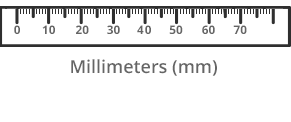What is Pupillary Distance?
Pupillary distance (PD) is quite simply the distance between your two pupils. Your PD is measured in millimeters and is necessary for creating your custom prescription eyeglasses. Your PD allows an optician to properly position your lenses within a frame of your choice in order for you to see.
Typically, most adults have PDs between 55-65 mm. For kids, PDs are usually between 42-54 mm.
How to Measure PD
You can often get your PD measurement from your doctor or a licensed optician. However, pupillary distance is also easy to measure yourself! With a pupillary distance ruler (in other words, any millimeter ruler), you can measure the distance between the center of your pupils yourself in a mirror or have a friend help out.
3 Simple Steps
-
1
Place a millimeter ruler on the bridge of your nose.

-
2
Have a friend face you about arm's length away.

-
3
Have your friend measure the distance between the center of your pupils (the black dots in the middle of your eyes).

Video Guide
This video explains what a PD (Pupillary Distance) is and how to measure it.
What is AccuPD?
AccuPD is our free interactive tool that allows you to measure your own pupillary distance right from your phone! The doctors behind 39DollarGlasses.com developed this PD measurement tool as part of our continued efforts to make shopping for prescription glasses easy and affordable.
Getting an accurate PD measurement is now even easier than taking a selfie, thanks to AccuPD from 39DollarGlasses.com. All you’ll need is your smartphone and a credit card (or another card that’s the same size).
How to Read Pupillary Distance: Single PD vs. Dual PD
Typically, there will only be one number in your PD measurement - this is called Single PD, and it can be used to order most types of prescription eyeglasses.
But if you have two different numbers, you have been measured for Dual PD (also known as monocular PD). In this scenario, the numbers are measurements of the distances from each pupil to the bridge of your nose - the first number refers to the left eye distance, and the second to the right. Added together, these numbers should equal the full distance measured between your two pupils. Dual PD is required for reading glasses, but not usually necessary otherwise.
- Two of the same number (e.g. 30/30): This is the same as a Single PD measurement between the pupils. When entering this information to order your glasses, you can just add these together and we’ll automatically divide it equally.
- Two low numbers (e.g. 30/31): The first number is the monocular PD for the right eye (O.D.) and the second number is for the left eye (O.S.).
- Two high numbers (e.g. 62/59): This is used only for reading glasses. The first number is your Distance PD and the second number is your Near PD.
